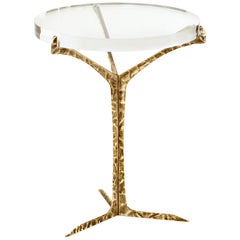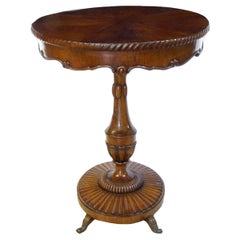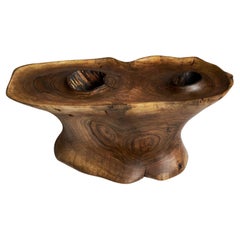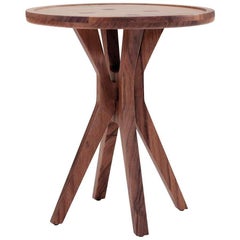New in Europe - End Tables
3
2
1
to
2
6
12
6
5
5
1
1
3
3
Height
to
Width
to
Depth
to
5
2
2
1
1
5
1
1
1
1
1
1
1
Item Ships From: Europe
This Week's Listings Only
Alentejo Side Table, Acrylic & Brass, InsidherLand by Joana Santos Barbosa
By InsidherLand, Joana Santos Barbosa
Located in Maia, Porto
Alentejo side table is a glimpse over the South of Portugal where thousands of cork oaks trees raise their canopies to the sky.
Resembling the typ...
Category
21st Century and Contemporary Portuguese Modern New in Europe - End Tables
Materials
Brass
French Charles X End table Sewing Box, wood and inlaid brass
Located in Valladolid, ES
Gorgeous and very refined and elegant Charles X sewing box and leaf shaped table , around 1830 France. This small side table is made of mahogany wood and gold brass threaded inlays...
Category
1830s French Charles X Antique New in Europe - End Tables
Materials
Metal
EARLY 19th CENTURY OVAL COFFEE TABLE
Located in Firenze, FI
Elegant and refined, this coffee table was probably designed by the architect Agostino Fantastici, known in Italy for creating the most prestigious furniture of the Tuscan nobility b...
Category
Early 19th Century Italian Antique New in Europe - End Tables
Materials
Walnut
Black Wood Pedestal Round Side Tables by Kelly Forslund, Set of Two
Located in London, GB
The side tables by Kelly Forslund are casually sophisticated with a modern aesthetic, these black pedestal round side tables are made from dark wood with a glossy sheen. The double ...
Category
21st Century and Contemporary New in Europe - End Tables
Materials
Wood
Solid Wood Sculptural Side Table, Original Contemporary Design, Logniture
By Logniture
Located in Stara Gradiška, HR
Unique chainsaw carved wooden functional sculpture usable as a multifunctional piece such as a side table. Carved from a single piece of wood and protected with the highest quality o...
Category
21st Century and Contemporary Croatian New in Europe - End Tables
Materials
Wood, Walnut
19th-Century Side Table with Ceramic Top
Located in Opole, PL
19th-Century Side Table with Ceramic Top
The ceramic top depicts a genre scene of “a woman coming back from the forest.” - hand painted.
The section under the top with openwork cut...
Category
Late 19th Century Dutch Rococo Antique New in Europe - End Tables
Materials
Ceramic, Wood
Related Items
Contemporary Boton Two Side Table in Conacaste Solid Wood by Labrica
By Labrica, Ricardo Velasquez
Located in Oakland Park, FL
Inspired by old brass buttons and cuff links, this series includes three different table tops each with a distinct base. The series continues to grow and each piece can be modified t...
Category
21st Century and Contemporary Guatemalan Modern New in Europe - End Tables
Materials
Wood
Tarnished Brass and Blackened Steel Block Side Table
By Stephen Kenn
Located in Los Angeles, CA
A modular stool and storage system created to accessorize a living space. Can be used facedown to act as stools or a small coffee table or turned upright...
Category
2010s American Modern New in Europe - End Tables
Materials
Steel
Solid Suar Wood Round Side Table Modern Organic
Located in Jimbaran, Bali
A wonderfully sculptural round side table, with an hourglass shape. Its neutral pigments make it perfect for any space. A uniquely sculptural and versatile piece certain to invoke co...
Category
21st Century and Contemporary Indonesian Organic Modern New in Europe - End Tables
Materials
Wood, Fruitwood
Tall Round Side Table, Pedestal Base, Walnut by Martin & Brockett, Brown
Located in Los Angeles, CA
Martin & Brockett 's Findley Round Tall Side Table features the Findley Collection's signature carved, curved lip edge on the table top and a round pedestal base. Shown here in Walnu...
Category
2010s American New in Europe - End Tables
Materials
Walnut
Solid Mango Wood Round Side Table Modern Organic
Located in Jimbaran, Bali
A wonderfully sculptural round side table with an engraved ribbed design on its sides. Its neutral pigments make it perfect for any space. A uniquely sculptural and versatile piece c...
Category
21st Century and Contemporary Indonesian Organic Modern New in Europe - End Tables
Materials
Wood, Fruitwood
Solid Suar Wood Round Side Table Modern Organic
Located in Jimbaran, Bali
A wonderfully sculptural round side table. Its neutral pigments make it perfect for any space. A uniquely sculptural and versatile piece certain to invoke conversation. It was crafte...
Category
21st Century and Contemporary Indonesian Organic Modern New in Europe - End Tables
Materials
Wood, Fruitwood
Transparent Acrylic Side Table with Multi-Purpose Sub-Seat Terrarium
By Thislexik, Vedat Ulgen
Located in Brooklyn, NY
Like the other members of our 'Bond Series', this completely transparent acrylic side/end table is defined by the trough nestled underneath its surface. The trough enables you to curate your own sub-seat terrarium, or to display your own accents, oddities, and other objects of intrigue. Its transparent nature allows the piece to house accents that compliment its surrounding environment while also creating a sense of spaces. This aesthetic flexibility allows the table to synergize perfectly with almost any design project.
This piece is a member of our 'Bond' Series, a line of acrylic furniture...
Category
21st Century and Contemporary American Modern New in Europe - End Tables
Materials
Acrylic
19th C. French Charles X Restoration Period Sewing Stand Work Table
Located in Forney, TX
A scarce period Charles X (1818-1834) French Restoration mahogany travailleuse sewing (thread stand - side table - jewelry dressing table) with light, warm, beautifully aged patina.
Born in France in the early 19th century, almost certainly Parisian work, exquisitely hand-crafted, this exceptionally executed example features ornate gilt bronze ormolu mounts, escutcheons, and elaborate gilt metal trim. Having a highly figured light mahogany hinged lid top, lifting open to reveal a striking finished interior with divided compartments and original inset mirror plate. The conforming rectangular case fitted with a faux drawer front over a dovetailed drawer with sectioned interior. Elegantly rising on oval-shaped medial shelf stretcher-joined curvacious legs.
Dimensions (approx):
27" High, 20" Wide, 13.5" Deep
Stunning light almost blonde antique mahogany coloring and mellow warm tone, superb wood grain detail, and charming, beautifully aged patina over the whole. Great shape overall. Retaining original antique character marks, wear consistent with age and indicative of minimal use, nothing that detracts from the aesthetics or functionality, but only adds to the overall authenticity, refined elegant warmth, luxurious sophistication, and cozy unpretentious rustic elegance.
Delivered cleaned, hand waxed, polished French patina finish, ready for immediate use and generational enjoyment!
What is Charles X style:
The comte d’Artois – or Charles X - was the son of the dauphin Louis-Ferdinand de Franc and Marie-Josèphe de Saxe. He succeeded his two brothers Louis XVI and Louis XVIII and became the King of France in 1824. Thirty years after the French Revolution, he wanted to embody the return of monarchy and became the leader of the catholic party . As the previous kings, he was crowned in 1825 but he was soon overthrown by the revolution in July, 1830, called "Trois Glorieuses". He left then for England, Scotland, Prague and Istria where he died in 1836.
Charles X style lasted from 1818 to 1834 and happened during the Bourbon Restoration (French Restoration). This style did not replace totally the style of furniture from the French Empire but it was different from the formalism in the Napoleonic era, during which strictness and simplicity were inspired by Greco-Roman art. Indeed, artistic fields flourished. In terms of furniture, this renewal was suggested by the softening of shapes. Even though the simple aspect from the French Empire was still visible, shapes became curvier with volutes and arabesques. Another distinction is the loss of the massive aspect of furniture and the decrease of dimensions in order to decorate smaller appartments. Handling ability and comfort were key-words in the making of furniture. Apartments had essential elements such as chests of drawers, big rounded tables in the dining room, desks or secretaries, armoires and even dressing tables, comfortable fainting couches in the living room, small tables, pedestal tables, as well as gondola chairs. The wavy aspect of the latters certainly represent Charles X style the best.
One of the most emblematic features of this style is the use of bois clairs – light woods in warm blond tones - and indigenous woods that are varnished in order to highlight the grains. Bird's-eye maple, ash trees, plane trees, yew trees, beech trees, olive trees and cedar trees were most likely to be used. Indeed, at the beginning of the 19th century dark woods were hard to find. In 1806, the Napoleon’s Continental System was established in order to ruin the United Kingdom by preventing the country from any business with the rest of Europe. Therefore craftsmen had to find alternatives from mahogany which was the most commonly used material at this time. After 1815, the import of wood was even more difficult because of peace treaties and the European political situation, which contributed to the popularity of the bois clairs and indigenous woods. The furniture was often decorated with fine inlays made out of dark wood representing foliage, which contrasted with the veneer. Even though these patterns can look like bronze decorations from the Empire era, they were far more simple and did not represent any military or mythological attributes. On the tables, trays were sometimes made out of marble as in the French Empire, but it was often put aside and inlaid veneer, Verre Eglomisé – a type of glass with a mirror finish –, mirror or porcelain from Sèvres or Paris were more likely to be used.
Decorative elements from the Monarchy were highly appreciated again as they suggested luxury. Indeed, marquetry work was particularly fashionable - Boulle marquetry thrived around 1820 as the works of the Levasseur family can show. In the same way, draperies and trimmings referred to the monarchist splendour. Fabrics were often white – the traditional colour of the Bourbons – or light coloured as oppposed to the typical green from the Napoleonic era.
One of the most symbolic figures from this period of time might be Jean-Jacques Werner (1791-1849), a cabinetmaker who worked for prestigious clients such as the Duchesse de Berry who was Charles’s step-daughter. His works can be seen at the Musée des Arts Décoratifs and at the Grand Trianon in the Palace of Versailles. The duchess’s appartments situated at the pavillon de Marsan and at the Palais de Saint Cloud illustrate Charles X style the best with furniture made out of bois clairs and ornamented with dark wood patterns or fine gold decorations.
Chales X style allows a transition between the sobriety of the Empire style and the abundant aspect of Louis-Philippe style. The gothic style started at this time through the "style à la cathédrale", inspired by religious architecture, which thrived from 1827 to 1830. Indeed, at the beginning of the 19th century, Romanticism put the spotlight on the Middle Ages. Cabinetmakers were not inspired by the medieval furniture but rather by architectural elements of churches and cathedrals. For instance the backs of chairs were decorated with arches shaped like rib and serration. In the same way, before Charles X abdicated, pieces of furniture were made out of dark woods – such as mahogany, which was used again in France – and were inlaid with light wood. Romanticism also influenced the layout of furniture in appartments to suggest movement through a mix of various styles, various shapes and various sizes, as opposed to the static aspect of Neoclassicism. The start of industrialisation and mechanisation also influenced this style as early technical developments led to the production of pieces of furniture in series.
Credit:
Marc Maison
Bibliography:
FANIEL Stéphane (Dir.), Le Dix-neuvième Siècle Français, Collection Connaissance des Arts, 1957, Hachette
SASSONE, Adriana Boidi, Furniture from Rococo to Art Deco, 2000, Evergreen
--
Extremely versatile:
As warm and attractive as it is useful, this remarkable antique table having the ideal size and small proportions for a variety of different uses, including as a side table, accent or occasional table, tall sofa...
Category
Early 19th Century French Charles X Antique New in Europe - End Tables
Materials
Bronze, Ormolu
Painted Wood Pedestal Table
Located in Houston, TX
Painted wood pedestal table, hand carved as an Ionic style column in late 19th century, France.
Note: Regional differences in humidity and climat...
Category
Late 19th Century French Neoclassical Revival Antique New in Europe - End Tables
Materials
Wood
Early 19th Century Printer's Paper Press
Located in Dallas, TX
Early 19th century Printer's paper press is a superlative artifact from a bygone era, that will provide storage like a chest of drawers, an intriguing tabl...
Category
Early 19th Century Dutch Dutch Colonial Antique New in Europe - End Tables
Materials
Brass
19th Century French Louis XVI Oval Nightstand
Located in Dallas, TX
19th century French Louis XVI oval nightstand is a gracefully executed transitional piece, combining a neoclassical essence with the elegance of four s...
Category
1890s French Louis XVI Antique New in Europe - End Tables
Materials
Walnut
19th Century French Bamboo Side Table
Located in High Point, NC
19th Century tortoise bamboo side table from France with a hand painted chinoiserie top and lower shelf. The frame is very interesting and unusual. It is made from tortoise bamboo an...
Category
19th Century French Art Nouveau Antique New in Europe - End Tables
Materials
Bamboo
Recently Viewed
View AllMore Ways To Browse
Art Deco Entry Cabinet
Faux Bamboo And Glass End Table
3 Leg French End Tables
Cantilever End Table
Metal Glass Round End Table
Louis Xv Antique End Table
Pair Of Louis Xv End Tables
Scandinavian Rosewood End Table
Step End Table Pair
Square End Tables With Marble Top
Round Chrome End Table
Square End Table Cabinet
Antique Bedside End Tables
Brass Based Marble Top End Tables
End Table With Leather Tops
Morrocan End Table
Brass Faux Bamboo End Table
Entry Cupboard





